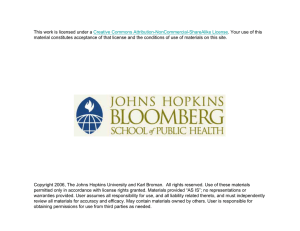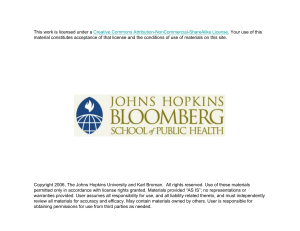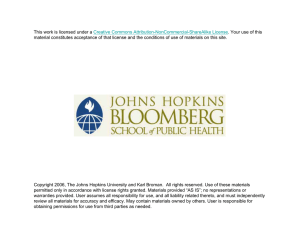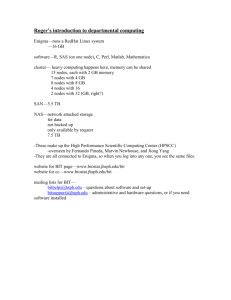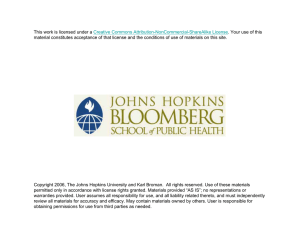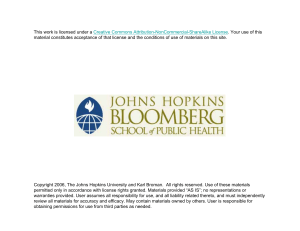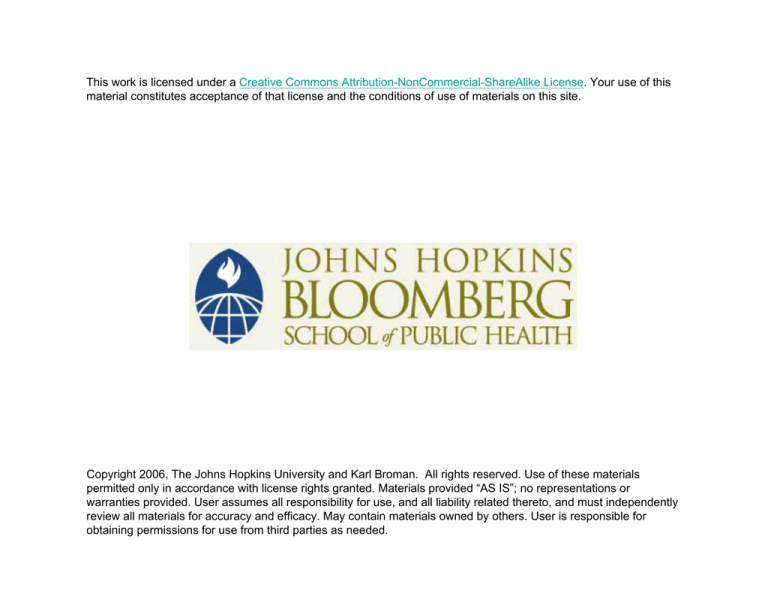
This work is licensed under a Creative Commons Attribution-NonCommercial-ShareAlike License. Your use of this
material constitutes acceptance of that license and the conditions of use of materials on this site.
Copyright 2006, The Johns Hopkins University and Karl Broman. All rights reserved. Use of these materials
permitted only in accordance with license rights granted. Materials provided “AS IS”; no representations or
warranties provided. User assumes all responsibility for use, and all liability related thereto, and must independently
review all materials for accuracy and efficacy. May contain materials owned by others. User is responsible for
obtaining permissions for use from third parties as needed.
Homework for lecture 8
Page 1 of 3
Statistics for laboratory scientists
Homework problems for lecture 8
Some of these problems are taken from Sokal & Rohlf, Biometry.
You may want to use the computer to do the calculations.
1. In humans, the sex ratio of newborn infants is about 100 females :
105 males. If we were to take 10,000 random samples of 6 newborn
infants each from the total population of such infants for one year,
what would be the expected frequency (number) of groups of 6
males, 5 males, 4 males, and so on?
2. The Army Medical Corps is concerned about the intestinal disease X.
From previous experience they know that soldiers suffering from the
disease invariably harbor pathogenic organisms in their feces and
that for all practical purposes every disease stool specimen contains
these organisms. The organisms are never abundant, however, and
thus only 20% of all slides prepared by the standard procedure
contain some of them. (We assume that if an organism is present on
a slide, it will be seen.) How many slides per stool specimen should
the laboratory technicians prepare and examine to ensure that if a
specimen is positive, it will be erroneously diagnosed negative in less
than 1% of the cases (on the average)? On the basis of your answer,
would you recommend that the Corps attempt to improve their
diagnostic methods?
3. A cross is made in a genetic experiment in drosophila in which it is
expected that one-fourth of the progeny will have white eyes and
one-half will have the trait called singed bristles. Assume that the
two gene loci segregate independently.
a. What proportion of the progeny should exhibit both traits
simultaneously?
b. If 4 flies are sampled at random, what is the probability that
they will all have white eyes?
c. What is the probability that none of the 4 flies will have either
white eyes or singed bristles?
http://www.biostat.jhsph.edu/~kbroman/teaching/labstat/third/hw08.html
3/31/2006
Homework for lecture 8
Page 2 of 3
d. If 2 flies are sampled, what is the probability that at least one of
the flies will have white eyes or singed bristles or both traits.
4. Which is more likely, getting exactly 50 heads in 100 tosses of a fair
coin, or getting exactly 3 heads in 10 tosses of a fair coin? (Use the
computer.)
5. Let X denote the number of double-sixes in 36 rolls of a pair of fair,
six-sided dice.
a. What is the distribution of X?
b. What is Pr(X = 2)?
c. What is the expected value of X?
d. What is the SD of X?
e. What is Pr(X > 2)?
6. Suppose that 1/100,000 bacterial cells contain a mutation providing
resistance to substance A. Suppose I create a bunch of plates with
200,000 cells per plate. Let X = number of cells on a plate that are
resistant to substance A.
Then X should follow a Poisson(lambda=2) distribution.
a. What is E(X) (the mean number of cells in a plate that are
resistant to A)?
b. What is SD(X)?
c. Calculate Pr(X = 0).
d. Calculate Pr(X = 5).
e. Calculate Pr(X > 2).
7. Suppose Y is a random variable with E(Y) = 30 and SD(Y) = 5.
a. Let Z = (Y - 30)/5. Calculate E(Z) and SD(Z).
b. Let X = - Y. Calculate E(X) and SD(X).
http://www.biostat.jhsph.edu/~kbroman/teaching/labstat/third/hw08.html
3/31/2006
Homework for lecture 8
Page 3 of 3
c. Let R = 5 + Y/3. Calculate E(R) and SD(R).
8. Suppose U has a uniform(5, 10) distribution. Calculate the following.
a. E(U)
b. Pr(U = 6)
c. Pr(U > 6)
d. Pr(7 < U < 9)
[ 3rd term syllabus | 4rd term syllabus | R for
Windows ]
Last modified: Wed Feb 22 09:44:12
EST 2006
http://www.biostat.jhsph.edu/~kbroman/teaching/labstat/third/hw08.html
3/31/2006

